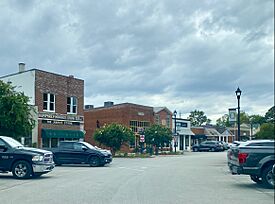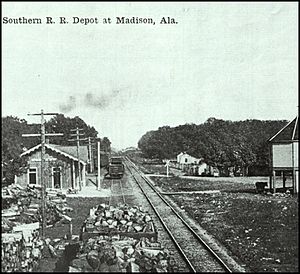Madison, Alabama facts for kids
Quick facts for kids
Madison, Alabama
|
|||
|---|---|---|---|

The Madison Historic District was added to the National Register of Historic Places on March 29, 2006.
|
|||
|
|||
| Motto(s):
Plant your roots
|
|||
| Country | United States | ||
| State | Alabama | ||
| Counties | Madison, Limestone | ||
| Founded | 1818 | ||
| Incorporated | December 2, 1869 | ||
| Area | |||
| • City | 30.694 sq mi (79.497 km2) | ||
| • Land | 30.563 sq mi (79.159 km2) | ||
| • Water | 0.131 sq mi (0.339 km2) | ||
| Elevation | 686 ft (209 m) | ||
| Population
(2020)
|
|||
| • City | 56,933 | ||
| • Estimate
(2023)
|
60,854 | ||
| • Rank | US: 649th AL: 9th |
||
| • Density | 1,968/sq mi (760.0/km2) | ||
| • Urban | 329,066 (US: 122nd) | ||
| • Urban density | 1,532/sq mi (591.6/km2) | ||
| • Metro | 514,465 (US: 109th) | ||
| • Metro density | 378/sq mi (145.9/km2) | ||
| • Combined | 879,315 (US: 68th) | ||
| • Combined density | 255.3/sq mi (98.57/km2) | ||
| Time zone | UTC−6 (Central (CST)) | ||
| • Summer (DST) | UTC−5 (CDT) | ||
| ZIP Codes |
35756, 35757, 35758
|
||
| Area code(s) | 256 and 938 | ||
| FIPS code | 01-45784 | ||
| GNIS feature ID | 2404989 | ||
Madison is a city in Alabama, a state in the United States. It is mostly in Madison County, but a small part extends into Limestone County. Madison is part of the larger Huntsville Metropolitan Area, which is the second-biggest city area in Alabama.
For many years, Madison was a small town with only about 400-500 people. Its population grew a lot when the Redstone Arsenal was built nearby. This brought many jobs and helped the city's economy grow. Many people who live in Madison work at Research Park or the Redstone Arsenal. Madison has become one of the fastest-growing and wealthiest cities in Alabama. In 2022, it was the 9th largest city in Alabama and the second largest in North Alabama, after Huntsville.
Contents
History of Madison
Long ago, the area where Madison is now was home to the Koasati people. They spoke a language called Muskogean. Before them, many other indigenous cultures lived here for thousands of years.
The first European-American settler in Madison was John Cartwright in 1818. The city started as "Madison Station" in the 1850s. It grew around a stop on the Memphis & Charleston Railroad. Later, factories were built to make cotton products.
Madison's Role in the Civil War
Madison was the site of a battle during the American Civil War. On May 17, 1864, soldiers from Alabama, led by Col. Josiah Patterson, fought against Union soldiers. Patterson's men captured Union supplies and tore up the railroad tracks. They also took 66 prisoners. Union soldiers chased them, and there was another small fight later that day.
The town officially became a city on December 2, 1869. From 1880 to 1950, Madison remained a small rural town.
Growth and Development
After World War II, military and NASA operations moved to nearby Huntsville. This caused Madison's population to grow. New roads made it easier for people to live in Madison and work in Huntsville. By 1980, Madison had 4,057 people. The city continued to grow quickly as a suburb of Huntsville. In 1986, people in Madison voted to stay an independent city and not merge with Huntsville. By 2010, the population was 42,938, and by 2020, it reached 56,933.
Geography and Location
Madison covers about 30.694 square miles (79.497 square kilometers). Most of this area is land, with a small amount of water.
The city is located at 34°42′54″N 86°44′23″W / 34.71500°N 86.73972°W. Downtown Huntsville is about 11 miles east of Madison. However, Huntsville also borders Madison to the south and west. Other nearby cities include Athens, about 17 miles northwest, and Decatur, about 16 miles southwest.
Population and People
| Historical population | |||
|---|---|---|---|
| Census | Pop. | %± | |
| 1880 | 410 | — | |
| 1900 | 412 | — | |
| 1910 | 426 | 3.4% | |
| 1920 | 435 | 2.1% | |
| 1930 | 431 | −0.9% | |
| 1940 | 455 | 5.6% | |
| 1950 | 530 | 16.5% | |
| 1960 | 1,435 | 170.8% | |
| 1970 | 3,086 | 115.1% | |
| 1980 | 4,057 | 31.5% | |
| 1990 | 14,904 | 267.4% | |
| 2000 | 29,329 | 96.8% | |
| 2010 | 42,938 | 46.4% | |
| 2020 | 56,933 | 32.6% | |
| 2023 (est.) | 60,854 | 41.7% | |
| U.S. Decennial Census 2020 Census |
|||
2020 Census Information
| Race | Number | Percentage |
|---|---|---|
| White (non-Hispanic) | 37,194 | 65.33% |
| Black or African American (non-Hispanic) | 8,367 | 14.7% |
| Native American | 175 | 0.31% |
| Asian | 4,426 | 7.77% |
| Pacific Islander | 73 | 0.13% |
| Other/Mixed | 3,410 | 5.99% |
| Hispanic or Latino | 3,288 | 5.78% |
In 2020, Madison had 56,933 people living in the city. There were 20,787 households and 15,540 families. The population density was about 1,875 people per square mile. This means many people live in a small area.
2010 Census Information
In 2010, Madison had 42,938 people. The average household had 2.65 people. About 30.8% of the population was 19 years old or younger. Most people (61.0%) were between 20 and 64 years old. The median age was 37.0 years.
The people in Madison come from many different backgrounds. About 74.0% were White, 14.6% were Black or African American, and 7.0% were Asian. About 4.6% of the population was Hispanic or Latino. According to the Madison Chamber of Commerce, Madison was the fastest-growing city in Alabama in 2010.
Economy and Jobs
Family and Individual Income
In Madison, the average income for a household was $92,136. For families, the average income was $111,217. The average income per person was $41,490. A small number of families (3.9%) and people (4.9%) lived below the poverty line. This means their income was below a certain level.
Major Industries and Employers
Madison's biggest employer is Intergraph. This company creates computer software. It is owned by Hexagon, a company from Sweden. Hexagon has invested in Madison to help it grow. They are even working on a program to help maintain streetlights in the city.
Thousands of Madison residents also work in nearby Huntsville. They work at places like Cummings Research Park and Redstone Arsenal. These places have many jobs in technology and science. This has attracted many highly educated people to live in Madison.
Education System
The Madison City School System started in 1998. It teaches over 10,000 students from Madison and the town of Triana. This school system is often ranked as one of the best in Alabama. It is also considered one of the top 5 school systems in the entire country.
The school system has seven elementary schools for grades K-5. These include Columbia, Heritage, Horizon, Madison, Mill Creek, Rainbow, and Midtown Elementary Schools. There are three middle schools for grades 6-8: Discovery, Journey, and Liberty Middle Schools. For high school, grades 9-12, there are Bob Jones High School and James Clemens High School. Madison Elementary is the oldest school, built around 1936. Journey Middle School is the newest, opening in 2023.
In 2019, Madison residents voted to increase property taxes. This money helps fund school growth and expansion. These funds helped build Midtown Elementary School in 2020. They also helped build Journey Middle School, which opened for the 2023–2024 school year.
Local Media
Madison has had local newspapers for many years. The Madison Record and the Madison County Record have served the city since 1967. The Madison Weekly News was another local newspaper.
City Infrastructure
Roads and Transportation
Several main roads serve Madison. These include Interstate 565, US 72 (also called University Drive), and Madison Boulevard. These are important for travel from east to west. Roads like Slaughter Road, Hughes Road, Wall Triana Highway, and County Line Road help people travel north and south.
Rail and Air Travel
The Norfolk Southern railway has a main line and a smaller track running through Madison. The Port of Huntsville is just south of the city. This port includes the Huntsville International Airport and a center for cargo trains.
Public Transit
Transportation for Rural Areas of Madison County (TRAM) provides a "dial-a-ride" service. This means you can call and arrange for a ride.
Culture and Entertainment
Sports Teams
Madison is home to the Rocket City Trash Pandas. This is a Double-A baseball team. They are part of the Southern League and are connected to the Los Angeles Angels. The team was supposed to start playing in Madison at Toyota Field in April 2020. However, due to health concerns, their first game was delayed until May 11, 2021.
Parks and Green Spaces
The City of Madison has many greenways and parks for people to enjoy. These are great places for outdoor activities. Madison is also working with Huntsville and Decatur to create a long trail. This trail will be about 70 miles long and will be used for biking and walking.
Notable People from Madison
- Mike Ball, a politician in Alabama
- Grant Dayton, a Major League baseball pitcher
- Lewie Hardage, an American football player and coach
- Robert Hoffman, an actor, dancer, and choreographer
- Bill Holtzclaw, a politician
- Kerron Johnson, a professional basketball player
- Kerryon Johnson, a professional football player
- Walter Jones, a Hall of Fame football player for the Seattle Seahawks
- Chip Lindsey, a college football coach
- Reggie Ragland, an American football linebacker
- Levi Randolph, a basketball player for Hapoel Jerusalem
See also
 In Spanish: Madison (Alabama) para niños
In Spanish: Madison (Alabama) para niños




